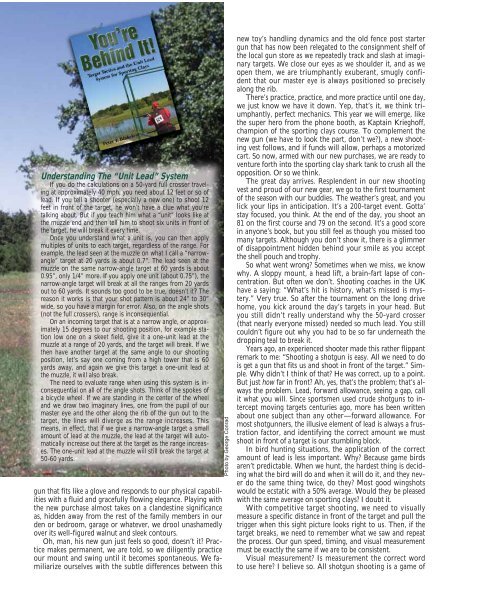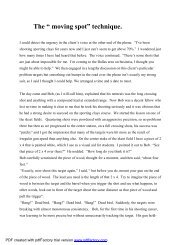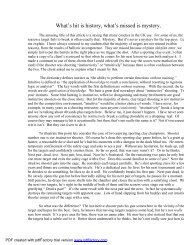ingredient
New Toy's Handling Dynamics And The Old Fence - Pete Blakeley
New Toy's Handling Dynamics And The Old Fence - Pete Blakeley
Create successful ePaper yourself
Turn your PDF publications into a flip-book with our unique Google optimized e-Paper software.
Understanding The “Unit Lead” SystemIf you do the calculations on a 50-yard full crosser travelingat approximately 40 mph, you need about 12 feet or so oflead. If you tell a shooter (especially a new one) to shoot 12feet in front of the target, he won’t have a clue what you’retalking about. But if you teach him what a “unit” looks like atthe muzzle end and then tell him to shoot six units in front ofthe target, he will break it every time.Once you understand what a unit is, you can then applymultiples of units to each target, regardless of the range. Forexample, the lead seen at the muzzle on what I call a “narrowangle”target at 20 yards is about 0.7”. The lead seen at themuzzle on the same narrow-angle target at 60 yards is about0.95”, only 1/4” more. If you apply one unit (about 0.75”), thenarrow-angle target will break at all the ranges from 20 yardsout to 60 yards. It sounds too good to be true, doesn’t it? Thereason it works is that your shot pattern is about 24” to 30”wide, so you have a margin for error. Also, on the angle shots(not the full crossers), range is inconsequential.On an incoming target that is at a narrow angle, or approximately15 degrees to our shooting position, for example stationlow one on a skeet field, give it a one-unit lead at themuzzle at a range of 20 yards, and the target will break. If wethen have another target at the same angle to our shootingposition, let’s say one coming from a high tower that is 60yards away, and again we give this target a one-unit lead atthe muzzle, it will also break.The need to evaluate range when using this system is inconsequentialon all of the angle shots. Think of the spokes ofa bicycle wheel. If we are standing in the center of the wheeland we draw two imaginary lines, one from the pupil of ourmaster eye and the other along the rib of the gun out to thetarget, the lines will diverge as the range increases. Thismeans, in effect, that if we give a narrow-angle target a smallamount of lead at the muzzle, the lead at the target will automaticallyincrease out there at the target as the range increases.The one-unit lead at the muzzle will still break the target at50-60 yards.gun that fits like a glove and responds to our physical capabilitieswith a fluid and gracefully flowing elegance. Playing withthe new purchase almost takes on a clandestine significanceas, hidden away from the rest of the family members in ourden or bedroom, garage or whatever, we drool unashamedlyover its well-figured walnut and sleek contours.Oh, man, his new gun just feels so good, doesn’t it? Practicemakes permanent, we are told, so we diligently practiceour mount and swing until it becomes spontaneous. We familiarizeourselves with the subtle differences between thisPhoto by George Conradnew toy’s handling dynamics and the old fence post startergun that has now been relegated to the consignment shelf ofthe local gun store as we repeatedly track and slash at imaginarytargets. We close our eyes as we shoulder it, and as weopen them, we are triumphantly exuberant, smugly confidentthat our master eye is always positioned so preciselyalong the rib.There’s practice, practice, and more practice until one day,we just know we have it down. Yep, that’s it, we think triumphantly,perfect mechanics. This year we will emerge, likethe super hero from the phone booth, as Kaptain Krieghoff,champion of the sporting clays course. To complement thenew gun (we have to look the part, don’t we?), a new shootingvest follows, and if funds will allow, perhaps a motorizedcart. So now, armed with our new purchases, we are ready toventure forth into the sporting clay shark tank to crush all theopposition. Or so we think.The great day arrives. Resplendent in our new shootingvest and proud of our new gear, we go to the first tournamentof the season with our buddies. The weather’s great, and youlick your lips in anticipation. It’s a 200-target event. Gotta’stay focused, you think. At the end of the day, you shoot an81 on the first course and 79 on the second. It’s a good scorein anyone’s book, but you still feel as though you missed toomany targets. Although you don’t show it, there is a glimmerof disappointment hidden behind your smile as you acceptthe shell pouch and trophy.So what went wrong? Sometimes when we miss, we knowwhy. A sloppy mount, a head lift, a brain-fart lapse of concentration.But often we don’t. Shooting coaches in the UKhave a saying: “What’s hit is history, what’s missed is mystery.”Very true. So after the tournament on the long drivehome, you kick around the day’s targets in your head. Butyou still didn’t really understand why the 50-yard crosser(that nearly everyone missed) needed so much lead. You stillcouldn’t figure out why you had to be so far underneath thedropping teal to break it.Years ago, an experienced shooter made this rather flippantremark to me: “Shooting a shotgun is easy. All we need to dois get a gun that fits us and shoot in front of the target.” Simple.Why didn’t I think of that? He was correct, up to a point.But just how far in front? Ah, yes, that’s the problem; that’s alwaysthe problem. Lead, forward allowance, seeing a gap, callit what you will. Since sportsmen used crude shotguns to interceptmoving targets centuries ago, more has been writtenabout one subject than any other—forward allowance. Formost shotgunners, the illusive element of lead is always a frustrationfactor, and identifying the correct amount we mustshoot in front of a target is our stumbling block.In bird hunting situations, the application of the correctamount of lead is less important. Why? Because game birdsaren’t predictable. When we hunt, the hardest thing is decidingwhat the bird will do and when it will do it, and they neverdo the same thing twice, do they? Most good wingshotswould be ecstatic with a 50% average. Would they be pleasedwith the same average on sporting clays? I doubt it.With competitive target shooting, we need to visuallymeasure a specific distance in front of the target and pull thetrigger when this sight picture looks right to us. Then, if thetarget breaks, we need to remember what we saw and repeatthe process. Our gun speed, timing, and visual measurementmust be exactly the same if we are to be consistent.Visual measurement? Is measurement the correct wordto use here? I believe so. All shotgun shooting is a game of





